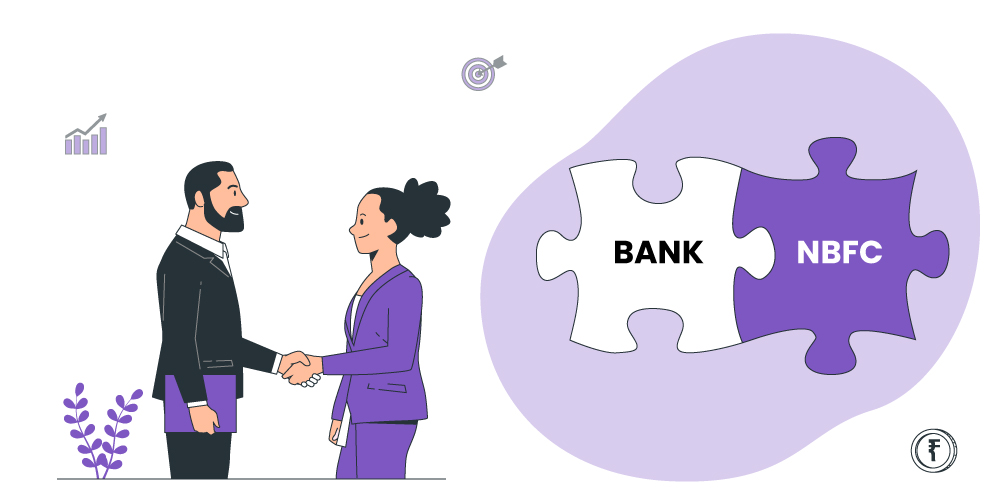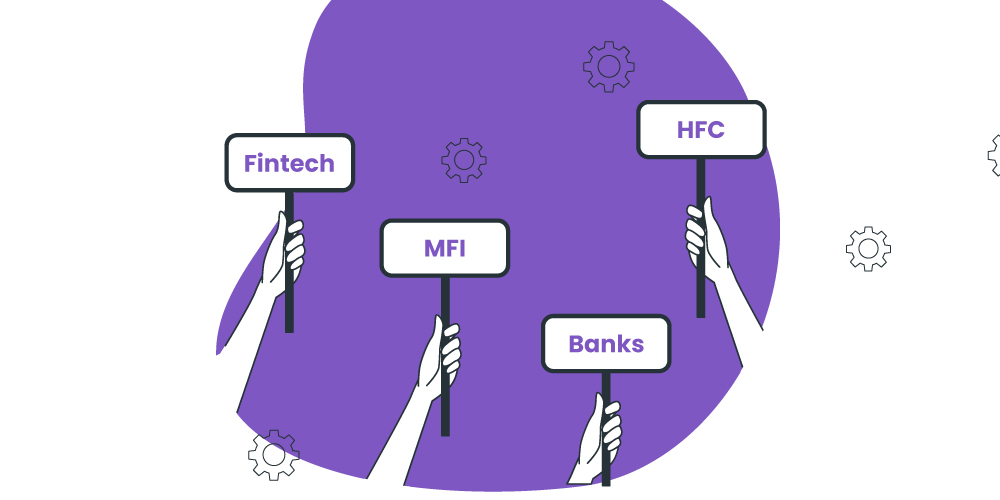In the past few months, the Indian lending ecosystem has witnessed many new pacts between banks and NBFCs. Experts believe that these co-lending/co-origination pacts will help lenders improve their credit outreach and significantly extend accessibility for many underserved borrowers in the country.
According to a report by the Association of Chartered Certified Accountants (ACCA), the Indian MSME segment faces a credit deficit of nearly $240 Bn.
(Source: https://accaindia.co.in/contenthub/Articles/images/ACCA_june.pdf)
Another emerging challenge to Indian lenders was highlighted by the Chairman of SBI, Mr. Dinesh Khara, when he called on the banking sector to increase their green lending activities to invest in sectors like renewable energy and sustainable infrastructure, while simultaneously helping other sectors like agriculture, to mitigate the effects of climate change.
To address the challenge of the rising credit gap within the underserved economy, RBI has introduced this new model of partnership between banks and NBFCs.
In this article, we will decode the Co-Lending Model (CLM) and why it can become a key to winning more market share for Indian lenders.

What is Co-lending?
Co-lending is an arrangement where banks and non-banks (NBFCs) can form agreements and engage in priority sector lending.
In India, RBI proposed a framework for co-lending, known as the co-lending model (CLM), in 2020. According to the master directions from RBI, financial institutions must direct 40% of all lending activities towards priority sectors as they contain many credit-starved borrowers. The list includes:
- Agriculture
- MSME
- Export Credit
- Education
- Housing
- Social Infrastructure
- Renewable Energy
Although Indian banks have ample funds and can offer loans at significantly lower rates, stringent regulations and poor outreach infrastructure hamper their ability to extend credit to the unorganized segments (that also contain many borrowers in these priority sectors). NBFCs, on the other hand, due to their agile nature and less stringent regulation, enjoy greater penetration into the market.
While NBFCs usually have agile frameworks, they can still suffer from liquidity crises.
An example of such a situation was the 2018 IL&FS crisis. It was fueled primarily by the lack of asset and liability management (ALM).
The crisis was a wake-up call for many NBFCs to create an adequate pool of credit. Additionally, to ensure that there aren’t any future liquidity crises, RBI in 2019 issued guidelines for all NBFCs to build a Liquidity Risk Management Framework. It would create a more regulated flow of credit and would result in improved credibility of NBFCs.
In this next section, you will find out about requirements for banks and NBFCs to enter into the CLM.
How does co-lending work?

Banks and NBFCs were forming pacts to pursue new markets well before the introduction of CLM. Previously, RBI had released a notification on 21st Sept 2018 titled ‘Co-origination of loans by Banks and NBFCs for lending to priority sector‘ highlighting rules and regulations for the parties involved in co-lending.
On 5th Nov 2020, RBI released another notification titled ‘Co-Lending by Banks and NBFCs to Priority Sector‘ that served as a revision to the 2018 directions.
Under this new version, all NBFCs (including HFCs) can enter co-lending pacts with partner banks. RBI mandated that some bank categories under Scheduled Commercial Banks (SCBs) cannot enter co-lending pacts with NBFCs. These banks include:
- Regional Rural Banks (RRBs)
- Small Finance Banks (SFBs)
- Urban Co-operative Banks (UCBs)
- Local Areas Banks (LABs)
Here’s what you need to know about CLM
- The bank/NBFC involved must formulate a board-approved policy that shall contain all the details regarding the exercise. The master agreement must be audited periodically, internally, and externally. The agreement must ensure adherence to the laid-out guidelines. Also, banks shall not enter a co-lending arrangement with any NBFC belonging to their promoter group.
- 80% of the total credit risk under this model shall be on the bank’s loan book and the NBFC should bear the rest 20% of the risk. While engaging in the activity, inter-alia, the partner bank must adhere to the outsourcing guidelines and not outsource its part of the credit sanction to the NBFC.
- The participants will pool all their funds required for lending activity within an escrow account – same for repayment.
- For customers, the NBFC/HFC shall be the interface for all activities. The partner bank can choose to undertake its share of the loans in two ways:
- During the formulation of the master agreement, the bank can choose to mandatorily take their share of loans and conduct the required due diligence to check if the prospective borrower matches their risk appetite or not. Banks must conduct the screening in adherence to all EKYC and AML guidelines laid out by the RBI.
- The other arrangement is for the NBFC to disburse 100% of the loan amount and then present the case to the bank. The bank can then ‘cherry-pick‘ these cases and finance them accordingly. This arrangement will be akin to a direct assignment transaction. The partner bank must adhere to the terms mentioned in the guidelines on Transactions Involving Transfer of Assets through Direct Assignment of Cash Flows and the Underlying Securities while taking the loans in its portfolio.
- During the formulation of the master agreement, the bank can choose to mandatorily take their share of loans and conduct the required due diligence to check if the prospective borrower matches their risk appetite or not. Banks must conduct the screening in adherence to all EKYC and AML guidelines laid out by the RBI.
- A co-lender can assign loans to a third party only with consent of the other partner lenders.
Also, at any time:
- The NBFC must have the ability to generate a unified statement for any customer via the appropriate information sharing mechanisms with the partner bank.
- The interest rates charged to the borrowers will be all-inclusive interest. It means that the partner bank/NBFC can mutually decide, and charge interest based on their risk appetite.
- The lenders must disclose all the details of their arrangement upfront to the customer and take explicit consent before signing them up.
- Lenders must set up a robust grievance redressal mechanism. Any complaints against the participating entities must be resolved within 30 days. If not addressed, the borrower can escalate the issue with the concerned Banking Ombudsman/Ombudsman for NBFCs or the Customer Education and Protection Cell (CEPC) in RBI.
- Both the banks and the NBFCs must create and implement a business continuity plan to ensure uninterrupted service to their borrowers till repayment of the loans under the co-lending agreement or in the event of termination of co-lending arrangement between the co-lenders.
What are the challenges associated with CLM?
Although CLM has many benefits, there are a few challenges in the model that can reduce its efficacy. For instance, there are challenges in the way banks can undertake loans from NBFCs. We earlier mentioned that it can be done in either two ways:
- By mandatorily taking their share of loans per the guidelines from the Master agreement from the partner NBFCs and then conducting due diligence
- By choosing their share per convenience from the basket of loans that the NBFCs have financed already
If we go by the first approach, there lies a risk in increasing the overall timeline of the journey. While banks can, in theory, rely upon the NBFCs to perform required checks. But if they choose to conduct these checks themselves with their relatively stricter due diligence (which banks prefer usually to avoid bad loans), it can overturn the advantages that NBFCs bring to this partnership.
In the second approach wherein the loan takeover by the partner bank is akin to digital assignment transaction, there are many aspects that pose operational challenges for the model. In order for this partnership to become successful, banks must address these challenges first. Some of these include – adherence to direct assignment guidelines, security creation and recovery, the takeover of loans and credit enhancement.
Thus, both the partner bank and NBFC will have to shape their policies in a way to maximize the flexibility of this arrangement while keeping in mind the convenience of the borrower.
What are the benefits of CLM?
CLM brings many benefits to the lending ecosystem. For example,
- It helps improve the relationship between banks and NBFCs.
- Creates a room for NBFCs to raise funds swiftly.
- Allows banks to enjoy greater flexibility while allocating more funds to underserved markets.
- Provide greater operational flexibility and bring down the loan interest rates to increase access to credit for millions of underbanked borrowers.
- Allow HFCs to enter co-origination pacts with banks (note that this was not allowed in the 2018 version of the co-origination framework).
- Borrowers can enjoy competitive interest rates, highly affordable loans, and access to higher loan amounts.
How can Digital improve the efficacy of CLM?

Over the last two years, India’s digital infrastructure has seen many innovations such as UPI, Digi-locker, e-KYC, e-Sign, OCEN, Account Aggregators, and more that have vastly improved the odds of success for CLM.
Now, the overall efficacy of CLM depends on the achievement of KPIs such as increasing the accuracy of credit profiling, lowering the cost of borrowing, faster TATs, minimal credit risk, higher operational flexibility, convenient repayment schedule, and more. A robust digital stack can help co-lenders create a truly paperless process that will significantly bring down the overall application processing time.
For example, LeadSquared hosts many capabilities to support co-lending needs such as:
- One time API integration to simplify the flow of data between multiple lending partners
- Rich data analytics and reporting to give you a 360-degree view into the customer lifecycle journey
- A Workflow Builder to build highly flexible and agile borrower journeys in just a few clicks
- Straight Through Processing (STP) for an end-to-end automated and completely paperless journey
- Partner Onboarding and Management for a seamless co-lending experience
- A robust Debt Recovery platform to minimize loan delinquencies and maximize collections
- Pre-screening functionality with checks such as Aadhar, PAN, CIBIL, Experian, and more
For example, Profectus Capital, a leading Indian NBFC was able to increase its funnel quality by over 70% using pre-screening capabilities offered by LeadSquared. Also, they were able to achieve 60% higher process efficiency and optimize their spending on DSAs by nearly 55%.
A robust tech stack will ensure that banks and NBFCs can make the most of their co-lending partnership and maximize the financial inclusion of the Indian borrowers.
Before we wrap up, let us look at some of the co-lending pacts signed in 2021.
List of Co-Lending pacts signed in 2021

2021 saw many banks (majorly public sector) and NBFCs come together to bridge the credit gap in the underserved segment. Housing finance and SME finance deals comprise nearly half of all new deals made in 2021. Here’s the list of the co-lending deals in 2021 so far.
Co-lending Deals Between Banks and HFCs
- Yes Bank – PNB Housing Finance
- Yes Bank – Indiabulls Housing Finance
- Central Bank of India – Indiabulls Housing Finance
- Central Banks of India – IIFL Home Finance
- Indian Bank – Indiabulls Housing Finance
- Indian Bank – IIFL Home Finance
- Punjab National Bank – IIFL Home Finance
- Punjab & Sind Bank – Indiabulls Home Finance
Co-lending Deals Between Banks and SME Finance NBFCs
- Bank of Baroda – U GRO Capital
- IDBI Bank – U GRO Capital
- Bank of India – MAS Financial Services
Other Co-lending Deals
- SBI – Paisalo Digital
- Yes Bank – WheelsEMI
- SBI – Vedika Credit Credit Capital Ltd.
- Indian Bank- Indiabulls Commercial Credit
- SBI- Save Microfinance
- Karur Vysya Bank – Chola Financial Services
- IndusInd Bank – Indel Money
- Prest Loans – U GRO Capital
- MAS Financial Services – CredAvenue
- Zip Loan – U GRO Capital
Conclusion
There is a rising credit demand in priority sectors that needs to be addressed.
The formalized framework of CLM supports and enables banks and NBFCs to cooperate and enjoy many benefits that were not available to them previously like greater penetration and swift access to funds.
By introducing CLM, RBI has already taken a positive step towards complete financial inclusion. It is now up to the lenders on how they can make this a successful initiative.
To make the most of their CLM partnerships, lenders must implement the right policies and use digital lending tools for agile operations.
To understand how LeadSquared Lending CRM can help supercharge your co-lending process.
FAQs
There are multiple ways by which NBFCs can raise funds. Here are a few:
– Loans from banks – usually long term but low-interest loans
– Raise funds via Non-convertible Debentures (NCDs)
– Via Foreign Direct Investment (FDI)
– By issuing commercial paper for short term loans
– By co-lending with banks
– Through Bonds
– By securitization of assets
Sectors in the market that do not receive adequate and timely credit are classified as Priority Sectors by the RBI. Any lending activity to these sectors falls under Priority Sector Lending. Since these are heavily underserved/underbanked, RBI has mandated Indian Banks to direct 40% of all lending activities into them. A few examples of such sectors are Agriculture, Education, Renewable Energy, MSMEs, Housing, etc.







